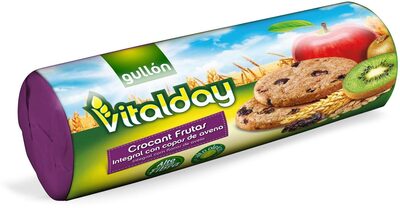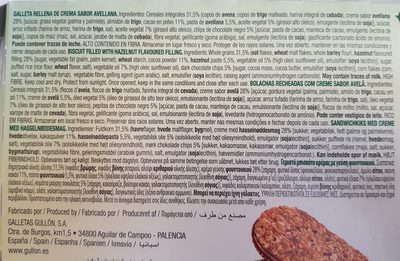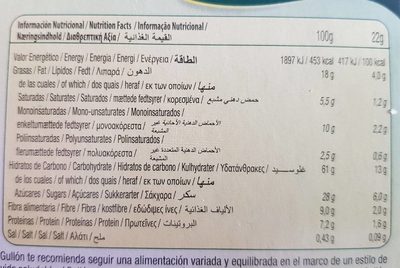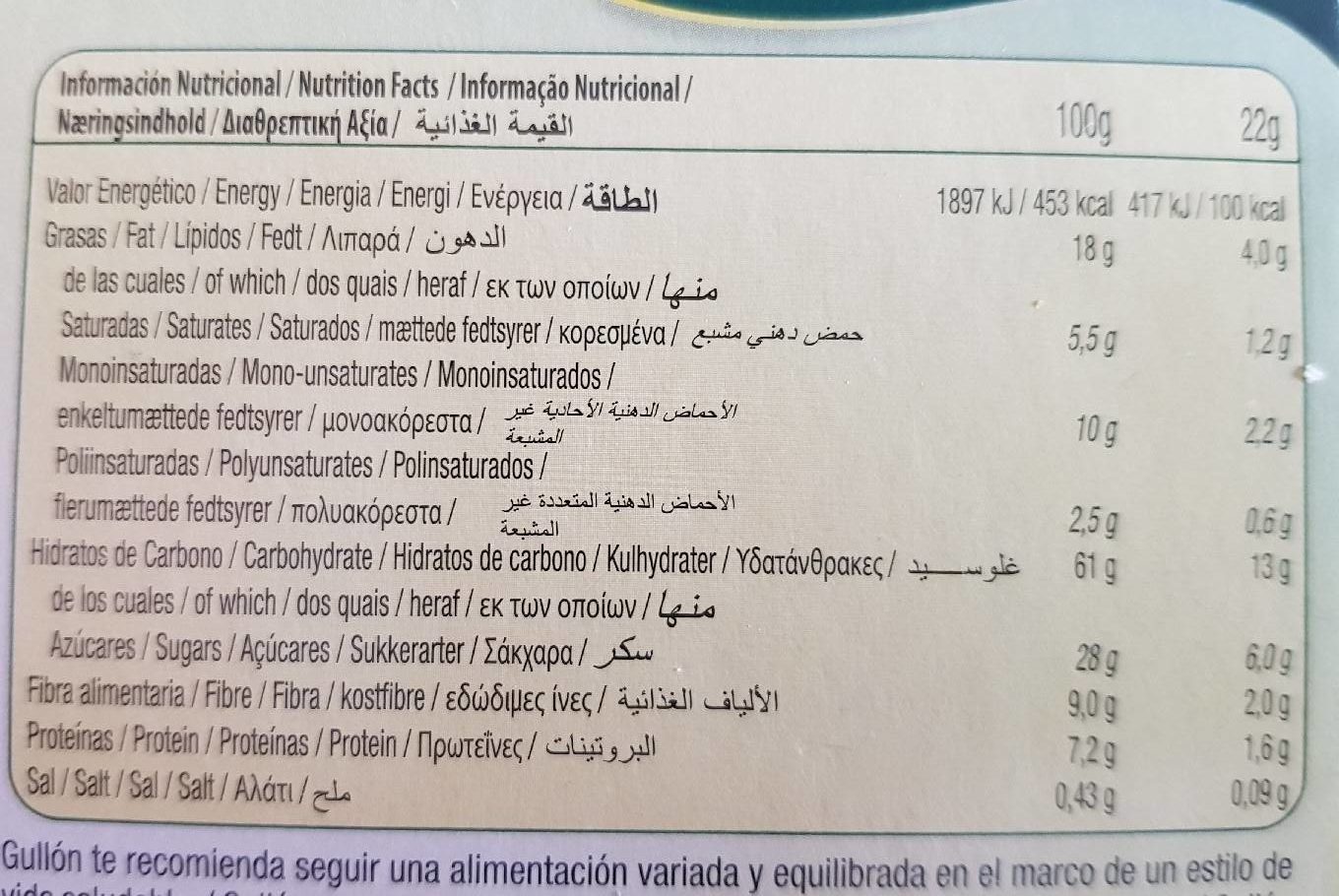Help us make food transparency the norm!
As a non-profit organization, we depend on your donations to continue informing consumers around the world about what they eat.
The food revolution starts with you!
Sandwich de avellana con avena y chips de chocolate Vitalday - Gullón - 300 g
Sandwich de avellana con avena y chips de chocolate Vitalday - Gullón - 300 g
This product page is not complete. You can help to complete it by editing it and adding more data from the photos we have, or by taking more photos using the app for Android or iPhone/iPad. Thank you!
×
Barra-kodea: 8410376046908 (EAN / EAN-13)
Izen arrunta: Galleta rellena de crema sabor avellana
Kopurua: 300 g
Ontziratzea: en:Plastic, en:Box, en:container
Kategoriak: en:Snacks, en:Breakfasts, en:Sweet snacks, en:Biscuits and cakes, Gaileta
Etiketak, ziurtagiriak, sariak: Source of fibre, High fibres
Manufacturing or processing places: Espagne burgos
Link to the product page on the official site of the producer: http://www.gullon.es/es/SandwichAvellana...
Dendak: pingo doce
Saltzen diren herrialdeak: Frantzia, Maroko, Portugal, Espainia
Matching with your preferences
Health
Osagaiak
-
42 ingredients
: Cereales integrales 31,5% (copos de avena, copos de trigo malteado, harina integral de cebada), crema sabor avellana 28% [azúcar, grasa vegetal (palma y palmiste), almidón de trigo, cacao en polvo 11%, pasta de avellana 5,5% , aceite vegetal 5% (girasol alto oleico), emulgente (lecitina de soja)], azúcar, arroz inflado (harina de arroz, harina de trigo, sal), aceite vegetal 7% (girasol alto oleico), chips de chocolate negro 5% [azúcar, pasta de cacao, manteca de cacao, emulgente (lecitina de soja), copos de maíz (maíz, sal, azúcar, jarabe de malta de cebada), fibra vegetal, gelificante (goma arábiga), sal, emulgente (lecitina de soja), gasificante (bicarbonato amónico).Alergenoak: en:Gluten, en:SoybeansAztarnak: en:Milk, en:Soybeans
Food processing
-
Ultra processed foods
Elements that indicate the product is in the 4 - Ultra prozesatutako elikagaiak eta edariak group:
- Gehigarria: E322
- Gehigarria: E414
- Osagaia: Emulsifier
- Osagaia: Gelling agent
Food products are classified into 4 groups according to their degree of processing:
- Prozesatu gabeko edo ahalik eta gutxien prozesatutako elikagaiak
- Sukaldaritzako osagaiak prozesatu
- Prozesatutako jakiak
- Ultra processed foods
The determination of the group is based on the category of the product and on the ingredients it contains.
Gehigarriak
-
E322
Lecithin: Lecithin -UK: , US: , from the Greek lekithos, "egg yolk"- is a generic term to designate any group of yellow-brownish fatty substances occurring in animal and plant tissues, which are amphiphilic – they attract both water and fatty substances -and so are both hydrophilic and lipophilic-, and are used for smoothing food textures, dissolving powders -emulsifying-, homogenizing liquid mixtures, and repelling sticking materials.Lecithins are mixtures of glycerophospholipids including phosphatidylcholine, phosphatidylethanolamine, phosphatidylinositol, phosphatidylserine, and phosphatidic acid.Lecithin was first isolated in 1845 by the French chemist and pharmacist Theodore Gobley. In 1850, he named the phosphatidylcholine lécithine. Gobley originally isolated lecithin from egg yolk—λέκιθος lekithos is "egg yolk" in Ancient Greek—and established the complete chemical formula of phosphatidylcholine in 1874; in between, he had demonstrated the presence of lecithin in a variety of biological matters, including venous blood, in human lungs, bile, human brain tissue, fish eggs, fish roe, and chicken and sheep brain. Lecithin can easily be extracted chemically using solvents such as hexane, ethanol, acetone, petroleum ether, benzene, etc., or extraction can be done mechanically. It is usually available from sources such as soybeans, eggs, milk, marine sources, rapeseed, cottonseed, and sunflower. It has low solubility in water, but is an excellent emulsifier. In aqueous solution, its phospholipids can form either liposomes, bilayer sheets, micelles, or lamellar structures, depending on hydration and temperature. This results in a type of surfactant that usually is classified as amphipathic. Lecithin is sold as a food additive and dietary supplement. In cooking, it is sometimes used as an emulsifier and to prevent sticking, for example in nonstick cooking spray.Source: Wikipedia (Ingeles)
-
E322i - Lezitina
Lecithin: Lecithin -UK: , US: , from the Greek lekithos, "egg yolk"- is a generic term to designate any group of yellow-brownish fatty substances occurring in animal and plant tissues, which are amphiphilic – they attract both water and fatty substances -and so are both hydrophilic and lipophilic-, and are used for smoothing food textures, dissolving powders -emulsifying-, homogenizing liquid mixtures, and repelling sticking materials.Lecithins are mixtures of glycerophospholipids including phosphatidylcholine, phosphatidylethanolamine, phosphatidylinositol, phosphatidylserine, and phosphatidic acid.Lecithin was first isolated in 1845 by the French chemist and pharmacist Theodore Gobley. In 1850, he named the phosphatidylcholine lécithine. Gobley originally isolated lecithin from egg yolk—λέκιθος lekithos is "egg yolk" in Ancient Greek—and established the complete chemical formula of phosphatidylcholine in 1874; in between, he had demonstrated the presence of lecithin in a variety of biological matters, including venous blood, in human lungs, bile, human brain tissue, fish eggs, fish roe, and chicken and sheep brain. Lecithin can easily be extracted chemically using solvents such as hexane, ethanol, acetone, petroleum ether, benzene, etc., or extraction can be done mechanically. It is usually available from sources such as soybeans, eggs, milk, marine sources, rapeseed, cottonseed, and sunflower. It has low solubility in water, but is an excellent emulsifier. In aqueous solution, its phospholipids can form either liposomes, bilayer sheets, micelles, or lamellar structures, depending on hydration and temperature. This results in a type of surfactant that usually is classified as amphipathic. Lecithin is sold as a food additive and dietary supplement. In cooking, it is sometimes used as an emulsifier and to prevent sticking, for example in nonstick cooking spray.Source: Wikipedia (Ingeles)
-
E414
Gum arabic: Gum arabic, also known as acacia gum, arabic gum, gum acacia, acacia, Senegal gum and Indian gum, and by other names, is a natural gum consisting of the hardened sap of various species of the acacia tree. Originally, gum arabic was collected from Acacia nilotica which was called the "gum arabic tree"; in the present day, gum arabic is collected from acacia species, predominantly Acacia senegal and Vachellia -Acacia- seyal; the term "gum arabic" does not indicate a particular botanical source. In a few cases so‐called "gum arabic" may not even have been collected from Acacia species, but may originate from Combretum, Albizia or some other genus. Producers harvest the gum commercially from wild trees, mostly in Sudan -80%- and throughout the Sahel, from Senegal to Somalia—though it is historically cultivated in Arabia and West Asia. Gum arabic is a complex mixture of glycoproteins and polysaccharides. It is the original source of the sugars arabinose and ribose, both of which were first discovered and isolated from it, and are named after it. Gum arabic is soluble in water. It is edible, and used primarily in the food industry as a stabilizer, with EU E number E414. Gum arabic is a key ingredient in traditional lithography and is used in printing, paint production, glue, cosmetics and various industrial applications, including viscosity control in inks and in textile industries, though less expensive materials compete with it for many of these roles. While gum arabic is now produced throughout the African Sahel, it is still harvested and used in the Middle East.Source: Wikipedia (Ingeles)
-
E503
Ammonium carbonate: Ammonium carbonate is a salt with the chemical formula -NH4-2CO3. Since it readily degrades to gaseous ammonia and carbon dioxide upon heating, it is used as a leavening agent and also as smelling salt. It is also known as baker's ammonia and was a predecessor to the more modern leavening agents baking soda and baking powder. It is a component of what was formerly known as sal volatile and salt of hartshorn.Source: Wikipedia (Ingeles)
-
E503ii
Ammonium carbonate: Ammonium carbonate is a salt with the chemical formula -NH4-2CO3. Since it readily degrades to gaseous ammonia and carbon dioxide upon heating, it is used as a leavening agent and also as smelling salt. It is also known as baker's ammonia and was a predecessor to the more modern leavening agents baking soda and baking powder. It is a component of what was formerly known as sal volatile and salt of hartshorn.Source: Wikipedia (Ingeles)
Ingredients analysis
-
en:Palm oil
Ingredients that contain palm oil: en:Palm, Palmiste olio
-
en:Vegan status unknown
Unrecognized ingredients: es:crema-sabor-avellanaSome ingredients could not be recognized.
We need your help!
You can help us recognize more ingredients and better analyze the list of ingredients for this product and others:
- Edit this product page to correct spelling mistakes in the ingredients list, and/or to remove ingredients in other languages and sentences that are not related to the ingredients.
- Add new entries, synonyms or translations to our multilingual lists of ingredients, ingredient processing methods, and labels.
If you would like to help, join the #ingredients channel on our Slack discussion space and/or learn about ingredients analysis on our wiki. Thank you!
-
en:Vegetarian status unknown
Unrecognized ingredients: es:crema-sabor-avellanaSome ingredients could not be recognized.
We need your help!
You can help us recognize more ingredients and better analyze the list of ingredients for this product and others:
- Edit this product page to correct spelling mistakes in the ingredients list, and/or to remove ingredients in other languages and sentences that are not related to the ingredients.
- Add new entries, synonyms or translations to our multilingual lists of ingredients, ingredient processing methods, and labels.
If you would like to help, join the #ingredients channel on our Slack discussion space and/or learn about ingredients analysis on our wiki. Thank you!
-
Details of the analysis of the ingredients
We need your help!
Some ingredients could not be recognized.
We need your help!
You can help us recognize more ingredients and better analyze the list of ingredients for this product and others:
- Edit this product page to correct spelling mistakes in the ingredients list, and/or to remove ingredients in other languages and sentences that are not related to the ingredients.
- Add new entries, synonyms or translations to our multilingual lists of ingredients, ingredient processing methods, and labels.
If you would like to help, join the #ingredients channel on our Slack discussion space and/or learn about ingredients analysis on our wiki. Thank you!
: Cereales integrales 31.5% (copos de avena, trigo, harina integral de cebada), crema sabor avellana 28% (azúcar, grasa vegetal (palma, palmiste), almidón de trigo, cacao en polvo 11%, pasta de avellana 5.5%, aceite vegetal 5% (girasol alto oleico), emulgente (lecitina de soja)), azúcar, arroz inflado (harina de arroz, harina de trigo, sal), aceite vegetal 7% (girasol alto oleico), chips de chocolate negro 5%, azúcar, pasta de cacao, manteca de cacao, emulgente (lecitina de soja), copos de maíz (maíz, sal, azúcar, jarabe de malta de cebada), fibra vegetal, gelificante (goma arábiga), sal, emulgente (lecitina de soja), gasificante (bicarbonato amónico)- Cereales integrales -> en:wholemeal-cereal - vegan: yes - vegetarian: yes - percent: 31.5
- copos de avena -> en:oat-flakes - vegan: yes - vegetarian: yes - ciqual_food_code: 9311
- trigo -> en:wheat - vegan: yes - vegetarian: yes - ciqual_proxy_food_code: 9410
- harina integral de cebada -> en:wholemeal-barley-flour - vegan: yes - vegetarian: yes - ciqual_food_code: 9550
- crema sabor avellana -> es:crema-sabor-avellana - percent: 28
- azúcar -> en:sugar - vegan: yes - vegetarian: yes - ciqual_proxy_food_code: 31016
- grasa vegetal -> en:vegetable-fat - vegan: yes - vegetarian: yes - from_palm_oil: maybe
- palma -> en:palm - vegan: yes - vegetarian: yes - from_palm_oil: yes - ciqual_food_code: 16129
- palmiste -> en:palm-kernel-oil - vegan: yes - vegetarian: yes - from_palm_oil: yes
- almidón de trigo -> en:wheat-starch - vegan: yes - vegetarian: yes - ciqual_proxy_food_code: 9510
- cacao en polvo -> en:cocoa-powder - vegan: yes - vegetarian: yes - ciqual_food_code: 18100 - percent: 11
- pasta de avellana -> en:hazelnut-paste - vegan: yes - vegetarian: yes - ciqual_food_code: 15004 - percent: 5.5
- aceite vegetal -> en:vegetable-oil - vegan: yes - vegetarian: yes - from_palm_oil: maybe - percent: 5
- girasol alto oleico -> en:high-oleic-sunflower - vegan: yes - vegetarian: yes - from_palm_oil: no - ciqual_food_code: 17440
- emulgente -> en:emulsifier
- lecitina de soja -> en:soya-lecithin - vegan: yes - vegetarian: yes - ciqual_food_code: 42200
- azúcar -> en:sugar - vegan: yes - vegetarian: yes - ciqual_proxy_food_code: 31016
- arroz inflado -> en:puffed-rice - vegan: yes - vegetarian: yes - ciqual_proxy_food_code: 9100
- harina de arroz -> en:rice-flour - vegan: yes - vegetarian: yes - ciqual_food_code: 9520
- harina de trigo -> en:wheat-flour - vegan: yes - vegetarian: yes - ciqual_proxy_food_code: 9410
- sal -> en:salt - vegan: yes - vegetarian: yes - ciqual_food_code: 11058
- aceite vegetal -> en:vegetable-oil - vegan: yes - vegetarian: yes - from_palm_oil: maybe - percent: 7
- girasol alto oleico -> en:high-oleic-sunflower - vegan: yes - vegetarian: yes - from_palm_oil: no - ciqual_food_code: 17440
- chips de chocolate negro -> en:dark-chocolate-chunks - vegan: maybe - vegetarian: yes - ciqual_proxy_food_code: 31074 - percent: 5
- azúcar -> en:sugar - vegan: yes - vegetarian: yes - ciqual_proxy_food_code: 31016
- pasta de cacao -> en:cocoa-paste - vegan: yes - vegetarian: yes - ciqual_proxy_food_code: 16030
- manteca de cacao -> en:cocoa-butter - vegan: yes - vegetarian: yes - ciqual_food_code: 16030
- emulgente -> en:emulsifier
- lecitina de soja -> en:soya-lecithin - vegan: yes - vegetarian: yes - ciqual_food_code: 42200
- copos de maíz -> en:corn-flakes - vegan: yes - vegetarian: yes - ciqual_food_code: 9200
- maíz -> en:corn - vegan: yes - vegetarian: yes - ciqual_food_code: 9200
- sal -> en:salt - vegan: yes - vegetarian: yes - ciqual_food_code: 11058
- azúcar -> en:sugar - vegan: yes - vegetarian: yes - ciqual_proxy_food_code: 31016
- jarabe de malta de cebada -> en:barley-malt-syrup - vegan: yes - vegetarian: yes
- fibra vegetal -> en:vegetable-fiber - vegan: yes - vegetarian: yes
- gelificante -> en:gelling-agent
- goma arábiga -> en:e414 - vegan: yes - vegetarian: yes
- sal -> en:salt - vegan: yes - vegetarian: yes - ciqual_food_code: 11058
- emulgente -> en:emulsifier
- lecitina de soja -> en:soya-lecithin - vegan: yes - vegetarian: yes - ciqual_food_code: 42200
- gasificante -> en:raising-agent
- bicarbonato amónico -> en:e503ii - vegan: yes - vegetarian: yes
Elikadura
-
Average nutritional quality
⚠ ️Warning: the amount of fruits, vegetables and nuts is not specified on the label, it was estimated from the list of ingredients: 5This product is not considered a beverage for the calculation of the Nutri-Score.
Positive points: 5
- Proteinak: 4 / 5 (balioa: 7.2, rounded value: 7.2)
- Fiber: 5 / 5 (balioa: 9, rounded value: 9)
- Fruits, vegetables, nuts, and colza/walnut/olive oils: 0 / 5 (balioa: 5.5, rounded value: 5.5)
Negative points: 13
- Energia: 5 / 10 (balioa: 1920, rounded value: 1920)
- Azukreak: 4 / 10 (balioa: 21, rounded value: 21)
- Gantz saturatua: 1 / 10 (balioa: 1.7, rounded value: 1.7)
- Sodioa: 3 / 10 (balioa: 300, rounded value: 300)
The points for proteins are not counted because the negative points are greater or equal to 11.
Nutritional score: (13 - 5)
Nutri-Score:
-
Nutrient levels
-
Koipe in moderate quantity (19%)
What you need to know- A high consumption of fat, especially saturated fats, can raise cholesterol, which increases the risk of heart diseases.
Recommendation: Limit the consumption of fat and saturated fat- Choose products with lower fat and saturated fat content.
-
Gantz-azido ase in moderate quantity (1.7%)
What you need to know- A high consumption of fat, especially saturated fats, can raise cholesterol, which increases the risk of heart diseases.
Recommendation: Limit the consumption of fat and saturated fat- Choose products with lower fat and saturated fat content.
-
Azukre in high quantity (21%)
What you need to know- A high consumption of sugar can cause weight gain and tooth decay. It also augments the risk of type 2 diabetes and cardio-vascular diseases.
Recommendation: Limit the consumption of sugar and sugary drinks- Sugary drinks (such as sodas, fruit beverages, and fruit juices and nectars) should be limited as much as possible (no more than 1 glass a day).
- Choose products with lower sugar content and reduce the consumption of products with added sugars.
-
Gatz arrunt in moderate quantity (0.75%)
What you need to know- A high consumption of salt (or sodium) can cause raised blood pressure, which can increase the risk of heart disease and stroke.
- Many people who have high blood pressure do not know it, as there are often no symptoms.
- Most people consume too much salt (on average 9 to 12 grams per day), around twice the recommended maximum level of intake.
Recommendation: Limit the consumption of salt and salted food- Reduce the quantity of salt used when cooking, and don't salt again at the table.
- Limit the consumption of salty snacks and choose products with lower salt content.
-
-
Nutrition facts
Nutrition facts As sold
for 100 g / 100 mlCompared to: Gaileta Energia 1.920 kj
(459 kcal)-% 3 Koipe 19 g -% 5 Gantz-azido ase 1,7 g -% 79 Gantz-azido monoasegabe 10 g -% 3 Polyunsaturated fat 2,5 g +% 25 Carbohydrates 59 g -% 8 Azukre 21 g -% 15 Fiber 9 g +% 140 Proteina 7,2 g +% 12 Gatz arrunt 0,75 g +% 26 Fruits‚ vegetables‚ nuts and rapeseed‚ walnut and olive oils (estimate from ingredients list analysis) 5,5 %
Ingurumena
-
Eco-Score D - High environmental impact
The Eco-Score is an experimental score that summarizes the environmental impacts of food products.→ The Eco-Score was initially developped for France and it is being extended to other European countries. The Eco-Score formula is subject to change as it is regularly improved to make it more precise and better suited to each country.Life cycle analysis
-
Average impact of products of the same category: B (Score: 69/100)
Kategoria: Biscuit (cookie)
Kategoria: Biscuit (cookie)
- PEF environmental score: 0.35 (the lower the score, the lower the impact)
- including impact on climate change: 2.88 kg CO2 eq/kg of product
Stage Impact Agriculture
80.5 %Processing
11.8 %Ontziratzea
3.1 %Transportation
3.2 %Distribution
1.4 %Consumption
0.0 %
Bonuses and maluses
-
Missing origins of ingredients information
Malus: -5
⚠ ️ The origins of the ingredients of this product are not indicated.
If they are indicated on the packaging, you can modify the product sheet and add them.
If you are the manufacturer of this product, you can send us the information with our free platform for producers.
-
Ingredients that threatens species
Malus: -10
Contains palm oil
Tropical forests in Asia, Africa and Latin America are destroyed to create and expand oil palm tree plantations. The deforestation contributes to climate change, and it endangers species such as the orangutan, the pigmy elephant and the Sumatran rhino.
-
Packaging with a high impact
Malus: -15
Shape Material Recycling Impact container Plastic Altua Box Unknown Altua ⚠ ️ The information about the packaging of this product is not sufficiently precise (exact shapes and materials of all components of the packaging).⚠ ️ For a more precise calculation of the Eco-Score, you can modify the product page and add them.
If you are the manufacturer of this product, you can send us the information with our free platform for producers.
Eco-Score for this product
-
Impact for this product: D (Score: 39/100)
Produktua: Sandwich de avellana con avena y chips de chocolate Vitalday - Gullón - 300 g
Life cycle analysis score: 69
Sum of bonuses and maluses: -30
Final score: 39/100
-
Carbon footprint
-
Equal to driving 1.5 km in a petrol car
288 g CO² per 100g of product
The carbon emission figure comes from ADEME's Agribalyse database, for the category: Biscuit (cookie) (Source: ADEME Agribalyse Database)
Stage Impact Agriculture
82.9 %Processing
7.9 %Ontziratzea
3.8 %Transportation
4.7 %Distribution
0.7 %Consumption
0.0 %
Ontziratzea
-
Packaging with a high impact
-
Packaging parts
container (Plastic)
Box
-
Bilgarriaren materialak
Material % Bilgarriaren pisua Bilgarriaren pisua produktuaren 100g-ko Plastic
-
Transportation
-
Origins of ingredients
Missing origins of ingredients information
⚠ ️ The origins of the ingredients of this product are not indicated.
If they are indicated on the packaging, you can modify the product sheet and add them.
If you are the manufacturer of this product, you can send us the information with our free platform for producers.Add the origins of ingredients for this product Add the origins of ingredients for this product
Threatened species
-
Contains palm oil
Drives deforestation and threatens species such as the orangutan
Tropical forests in Asia, Africa and Latin America are destroyed to create and expand oil palm tree plantations. The deforestation contributes to climate change, and it endangers species such as the orangutan, the pigmy elephant and the Sumatran rhino.
Report a problem
-
Incomplete or incorrect information?
Category, labels, ingredients, allergens, nutritional information, photos etc.
If the information does not match the information on the packaging, please complete or correct it. Open Food Facts is a collaborative database, and every contribution is useful for all.
Datuen iturria
Product added on by kiliweb
Last edit of product page on by packbot.
Produktuaren orria -gatik editatua dlc, maylord, openfoodfacts-contributors, scanbot, thaialagata, yuka.RnA0NVFaa3NyYWhUdHNjODFVdUo4UEFveGNDQ1htR3VOK0V6SVE9PQ, yuka.V2YwREM0QU45K3RhcWRwdThqcjczZUpYLzRDVVgzMlFET1lNSWc9PQ, yuka.WGFsYVM2WWRuZDQzb01NU3J6YlgwT0p0OThXT2IwYU1MY2d0SVE9PQ, yuka.ZTY4cU82WXNoOEpUaC9BTTlEak40L0JUM2IrclYxM3RLczAvSVE9PQ.










